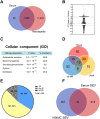Metabolic responsiveness to training depends on insulin sensitivity and protein content of exosomes in insulin-resistant males
- PMID: 34623918
- PMCID: PMC8500512
- DOI: 10.1126/sciadv.abi9551
Metabolic responsiveness to training depends on insulin sensitivity and protein content of exosomes in insulin-resistant males
Abstract
High-intensity interval training (HIIT) improves cardiorespiratory fitness (VO2max), but its impact on metabolism remains unclear. We hypothesized that 12-week HIIT increases insulin sensitivity in males with or without type 2 diabetes [T2D and NDM (nondiabetic humans)]. However, despite identically higher VO2max, mainly insulin-resistant (IR) persons (T2D and IR NDM) showed distinct alterations of circulating small extracellular vesicles (SEVs) along with lower inhibitory metabolic (protein kinase Cε activity) or inflammatory (nuclear factor κB) signaling in muscle of T2D or IR NDM, respectively. This is related to the specific alterations in SEV proteome reflecting down-regulation of the phospholipase C pathway (T2D) and up-regulated antioxidant capacity (IR NDM). Thus, SEV cargo may contribute to modulating the individual metabolic responsiveness to exercise training in humans.
Figures






References
-
- Stephens N. A., Sparks L. M., Resistance to the beneficial effects of exercise in type 2 diabetes: Are some individuals programmed to fail? J. Clin. Endocrinol. Metab. 100, 43–52 (2015). - PubMed
-
- Kacerovsky-Bielesz G., Kacerovsky M., Chmelik M., Farukuoye M., Ling C., Pokan R., Tschan H., Szendroedi J., Schmid A. I., Gruber S., Herder C., Wolzt M., Moser E., Pacini G., Smekal G., Groop L., Roden M., A single nucleotide polymorphism associates with the response of muscle ATP synthesis to long-term exercise training in relatives of type 2 diabetic humans. Diabetes Care 35, 350–357 (2012). - PMC - PubMed
-
- Sparks L. M., Exercise training response heterogeneity: Physiological and molecular insights. Diabetologia 60, 2329–2336 (2017). - PubMed
LinkOut - more resources
Full Text Sources
Medical
Molecular Biology Databases

